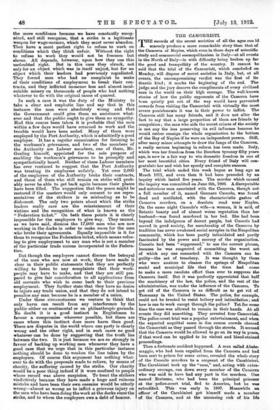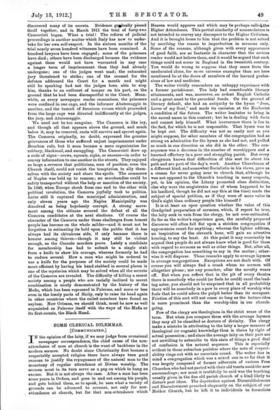THE CAMORRISTI.
THE records of the secret societies of all the ages con id scarcely produce a more remarkable story than that of
the Oamorra of Naples, which even in these days of scientific study and commercial cosmopolitanism in Italy—at all events in the North of Italy—is with difficulty being broken up for the good and tranquillity of the country. It cannot be said that the trial of the Camorristi, which concluded on Monday, will dispose of secret societies in Italy, but, at all events, the uncompromising verdict was the first of its drastic kind; it marks the beginning of the end. The judge and the jury deserve the compliments of every civilized man in the world on their high courage. The well-known stories of how the public opponents of the Cantorra have been quietly put out of the way would have prevente& cowards from visiting the Camorristi with virtually the most severe punishments it was in their power to inflict. The Camorra still has many friends, and it does not alter the fact to say that a large proportion of them are friends by compulsion; the man who aids the secret crimes of the society is not any the less preserving its evil influence because he would rather consign the whole organization to the bottom of the Bay of Naples if he were an independent person. Still, after many minor attempts to draw the fangs of the Camorra, a really serious beginning in reform has been made. Italy, which won her freedom from the Bourbon tyranny fifty years ago, is now in a fair way to win domestic freedom in one of her most beautiful cities. Every friend of Italy will con- gratulate her and wish her speedy and complete success.
The trial which ended this week began as long ago as March 1911, and even then it had been preceded by an inquiry which lasted five years. The murder which caused the inquiry was committed on June 6th, 1906. A disreputable and notorious man associated with the Camorra, though not a full member of it, named Gennaro Cuocolo, was found dead and mutilated, with the characteristic gashes of Camorra murders, on a desolate road near Naples. On the same night Cnocolo's wife—a woman, it is said, of Satanic beauty and of almost worse reputation than her husband—was found murdered in her bed. She had been beyond the indulgence of decent people, but Cuocolo had moved in good society, for membership of the Camorra by tradition has never awakened social scruples in the Neapolitan community, which has been partly intimidated and partly fascinated by the power and secrecy of the organization. Cuocolo had been " suppressed," to use the correct phrase, because he was suspected of committing the worst act of which any one connected with the Camorra can be guilty—the act of treachery. It was thought by those who were anxious to cleanse the springs of Neapolitan social and municipal life that the time had come to make a more resolute effort than ever to suppress the Camorra itself. But it was perfectly appreciated that half the machinery of the law, the police, and the rest of the administration, was under the influence of the Camorra. To get rid of the Camorra is as difficult as to get rid of Tammany in the United States. The police, for example, could not be trusted to resist bribery and intimidation ; and bow is one to work except through the police P Yet for some time the case was allowed to remain in their hands. At all events they did something. They arrested four Camorristi. The police-court trial was a popular entertainment, and when the expected acquittal came in due course crowds cheered the Camorristi as they passed through the streets. It seemed that the Camorra would be allowed to go on its way in peace, if that word can be applied to its violent and blood-stained proceedings.
Then a fortunate accident happened. A man called Abate- maggio, who bad been expelled from the Camorra and had been sent to prison for some crime, revealed the whole story of the Cuocolo murders to a sergeant of the Carabinieri. The Carabinieri took up the "case," and, acting with extra- ordinary courage, ran down every member of the Caniorra who was said to have had any part in the murders. One named Errieone, who had been the principal prisoner at the police-court trial, fled to America, but he was extradited. This was early in 1907. Meanwhile an officer of the Carabinieri got himself made a member of the Camorra, and at the unceasing risk of his life
discovered many of its secrets. Evidence gradually pieced itself together, and in March 1911 the trial of forty-two Camorristi began. What a trial ! The reform of judicial proceedings is another matter which Italy has now to under- take for her own self-respect. In the sixteen months of the trial nearly seven hundred witnesses have been examined. A hundred lawyers have been engaged; some of the prisoners have died; others have been discharged because the evidence against them would not have warranted in any case a longer term of imprisonment than they had already undergone; one of the judges went mad; the exhausted jury threatened to strike; one of the counsel for the defence addressed the Court for a month and might still be speaking had not the judges been able to stop him, thanks to an outburst of temper on his part, on the ground .that he had been disrespectful to the Court. Mean- while, as every newspaper reader remembers, the prisoners were confined in one cage, and the informer Abatemaggio in another, and the tumult of ferocious curses which proceeded from the large cage was directed indifferently at the judges, the jury, and Abatemaggio.
We need not he too sanguine. The Camorra is like ivy, and though all that appears above the ground, and much below it, may be removed, roots will survive and sprout again. The Camorra originally, no doubt, expressed the genuine grievances of those who suffered unjust imprisonment under Bourbon rule, but it soon became a mere organization for robbery, blackmail, and smuggling. The Camorristi drew up a code of signs—crows, squeals, sighs, or sneezes—in order to convey information to one another in the streets. They enjoyed so large a revenue that politicians, men of position, even the Church itself, could not resist the temptation to ally them- selves with the society and share the spoils. The commerce of Naples was held up to ransom; no merchandise could be safely transported without the help or sanction of the society. In 1848, when Europe shook from one end to the other with political revolution, the Camorra joyfully took to politics. Later still it captured the municipal administration, and only eleven years ago the Naples Municipality was dissolved as being hopelessly corrupt. A strong move- ment among the citizens secured the defeat of all the Camorra candidates at the next elections. Of course the character of the Camorra under these challenges from honest people has become on the whole milder—and it must not be forgotten in estimating its hold upon the public that it has always had its chivalrous side, if only because there is honour among thieves—though it may still be violent enough, as the Cuocolo murders prove. Lately a candidate for membership has had to submit to a single stab from a knife to show his courage, whereas formerly he had to endure several. How a man who might be ordered to use a knife for the purposes of the society could be made more efficient by having his hand stabbed in several places is one of the mysteries which may be solved when all the secrets of the Camorra are revealed. The difficulty of killing a secret society among a people who are racially inclined to secret combination is nicely demonstrated by the history of the Mafia, which has been repressed in Palermo, and more or less even in the lonely parts of Sicily, only to raise its head again in other countries where the exiled members have found an asylum. New Orleans, we should think, must be now as well acquainted as Palermo itself with the ways of the Mafia or its first-cousin, the Black Hand.







































 Previous page
Previous page